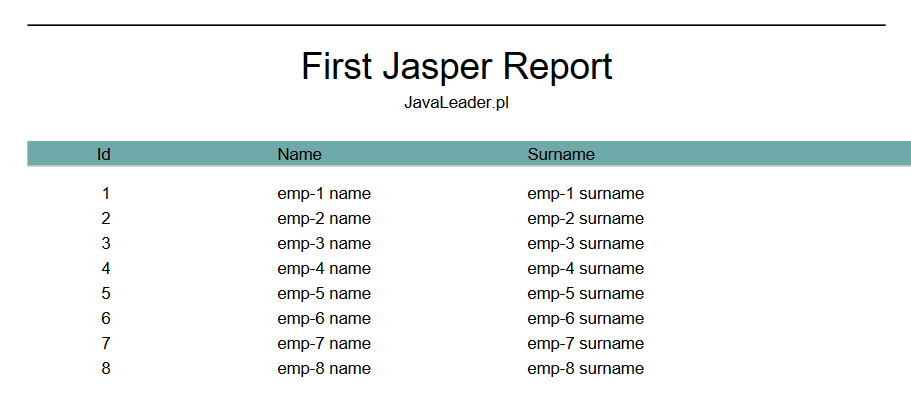Raporty Jaspera
Raporty Jaspera
Raport Jaspera to darmowy mechanizm/biblioteka który pozwala w łatwy sposób wygenerować raport na bazie danych pochodzących np. z zapytań SQL. Biblioteka ta pozwala ponadto na łatwy eksport raportu do popularnych formatów danych tj. np. *.pdf. Z tego artykułu dowiesz się w jaki sposób wygenerować prosty raport Jaspera w formacie PDF. Dane do raportu będą pochodziły z bazy H2. Tworzymy nowy projekt Spring Boota. Plik pom.xml – niezbędne zależności:
Plik pom.xml:
<?xml version="1.0" encoding="UTF-8"?> <project xmlns="http://maven.apache.org/POM/4.0.0" xmlns:xsi="http://www.w3.org/2001/XMLSchema-instance" xsi:schemaLocation="http://maven.apache.org/POM/4.0.0 https://maven.apache.org/xsd/maven-4.0.0.xsd"> <modelVersion>4.0.0</modelVersion> <parent> <groupId>org.springframework.boot</groupId> <artifactId>spring-boot-starter-parent</artifactId> <version>1.5.2.RELEASE</version> <relativePath/> <!-- lookup parent from repository --> </parent> <groupId>pl.javaleader</groupId> <artifactId>jasper</artifactId> <version>0.0.1-SNAPSHOT</version> <name>jasper</name> <description>Demo project for Spring Boot</description> <properties> <java.version>1.8</java.version> </properties> <dependencies> <dependency> <groupId>net.sf.jasperreports</groupId> <artifactId>jasperreports</artifactId> <version>6.4.0</version> </dependency> <dependency> <groupId>com.h2database</groupId> <artifactId>h2</artifactId> <version>1.3.148</version> </dependency> <dependency> <groupId>org.springframework.boot</groupId> <artifactId>spring-boot-starter-web</artifactId> </dependency> <dependency> <groupId>org.springframework.boot</groupId> <artifactId>spring-boot-starter-jdbc</artifactId> </dependency> <dependency> <groupId>org.projectlombok</groupId> <artifactId>lombok</artifactId> <version>1.18.12</version> <scope>provided</scope> </dependency> </dependencies> <build> <plugins> <plugin> <groupId>org.springframework.boot</groupId> <artifactId>spring-boot-maven-plugin</artifactId> </plugin> </plugins> </build> </project>
Plik application.properties opisujący dostęp do bazy danych H2:
spring.datasource.url=jdbc:h2:mem:testdb spring.datasource.driverClassName=org.h2.Driver spring.datasource.username=sa spring.datasource.password=password spring.jpa.database-platform=org.hibernate.dialect.H2Dialect spring.h2.console.enabled=true spring.h2.console.path=/h2-console
Klasa konfiguracyjna która definiuje źródło danych:
@Configuration public class AppConfig { @Bean @Primary @ConfigurationProperties(prefix = "spring.datasource") public DataSource primaryDataSource() { return DataSourceBuilder.create().build(); } }
Klasa modelu – korzystamy tutaj z biblioteki Lombok:
@Data public class Employee { private Long id; private String name; private String surname; }
Klasa serwisu:
public interface EmployeeService { List<Employee> findAll(); }
Implementacja serwisu – wykonywane zapytanie SQL zwracające listę wszystkich pracowników z bazy danych:
@Service public class EmployeeService implements EmployeeServiceImpl { @Autowired private JdbcTemplate jtm; @Override public List<Employee> findAll() { String sql = "SELECT * FROM Employee"; List<Employee> employees = jtm.query(sql, new BeanPropertyRowMapper(Employee.class)); return employees; } }
Klasa kontrolera odpowiadająca za generowanie raportu:
@Controller public class EmployeeController { @Autowired private ApplicationContext appContext; @Autowired private EmployeeServiceImpl employeeService; @RequestMapping(path = "/generate-pdf", method = RequestMethod.GET) public ModelAndView report() { JasperReportsPdfView view = new JasperReportsPdfView(); view.setUrl("classpath:employees.jrxml"); view.setApplicationContext(appContext); Map<String, Object> params = new HashMap<>(); params.put("spring.datasource", employeeService.findAll()); params.put("ReportTitle", "First Jasper Report"); params.put("Author", "JavaLeader.pl"); return new ModelAndView(view, params); } }
Plik ./resources/employees.jrxml który opisuje wygenerowany raport Jaspera:
<?xml version = "1.0" encoding = "UTF-8"?> <!DOCTYPE jasperReport PUBLIC "//JasperReports//DTD Report Design//EN" "http://jasperreports.sourceforge.net/dtds/jasperreport.dtd"> <jasperReport xmlns="http://jasperreports.sourceforge.net/jasperreports" xmlns:xsi="http://www.w3.org/2001/XMLSchema-instance" xsi:schemaLocation="http://jasperreports.sourceforge.net/jasperreports http://jasperreports.sourceforge.net/xsd/jasperreport.xsd" name="report2" pageWidth="595" pageHeight="842" columnWidth="555" leftMargin="20" rightMargin="20" topMargin="20" bottomMargin="20"> <parameter name = "ReportTitle" class = "java.lang.String"/> <parameter name = "Author" class = "java.lang.String"/> <field name="Id" class="java.lang.Long"> <fieldDescription><![CDATA[id]]></fieldDescription> </field> <field name="Name" class="java.lang.String"> <fieldDescription><![CDATA[name]]></fieldDescription> </field> <field name="Surname" class="java.lang.String"> <fieldDescription><![CDATA[surname]]></fieldDescription> </field> <title> <band height = "70"> <line> <reportElement x = "0" y = "0" width = "515" height = "1"/> </line> <textField isBlankWhenNull = "true" bookmarkLevel = "1"> <reportElement x = "0" y = "10" width = "515" height = "30"/> <textElement textAlignment = "Center"> <font size = "22"/> </textElement> <textFieldExpression class = "java.lang.String"> <![CDATA[$P{ReportTitle}]]> </textFieldExpression> <anchorNameExpression> <![CDATA["Title"]]> </anchorNameExpression> </textField> <textField isBlankWhenNull = "true"> <reportElement x = "0" y = "40" width = "515" height = "20"/> <textElement textAlignment = "Center"> <font size = "10"/> </textElement> <textFieldExpression class = "java.lang.String"> <![CDATA[$P{Author}]]> </textFieldExpression> </textField> </band> </title> <columnHeader> <band height = "23"> <staticText> <reportElement mode = "Opaque" x = "0" y = "0" width = "535" height = "15" backcolor = "#70A9A9" /> <box> <bottomPen lineWidth = "1.0" lineColor = "#CCCCCC" /> </box> </staticText> <staticText> <reportElement x = "0" y = "0" width = "50" height = "15" /> <textElement textAlignment = "Right" verticalAlignment = "Middle"> <font isBold = "true" /> </textElement> <text><![CDATA[Id]]></text> </staticText> <staticText> <reportElement x = "150" y = "0" width = "121" height = "15" /> <textElement textAlignment = "Left" verticalAlignment = "Middle"> <font isBold = "true" /> </textElement> <text><![CDATA[Name]]></text> </staticText> <staticText> <reportElement x = "300" y = "0" width = "136" height = "15" /> <textElement textAlignment = "Left" verticalAlignment = "Middle"> <font isBold = "true" /> </textElement> <text><![CDATA[Surname]]></text> </staticText> </band> </columnHeader> <detail> <band height="15"> <textField> <reportElement x="0" y="0" width="50" height="15" /> <textElement textAlignment="Right" verticalAlignment="Middle"/> <textFieldExpression class="java.lang.Long"> <![CDATA[$F{Id}]]> </textFieldExpression> </textField> <textField> <reportElement x="150" y="0" width="100" height="15" /> <textElement textAlignment="Left" verticalAlignment="Middle"/> <textFieldExpression class="java.lang.String"> <![CDATA[$F{Name}]]> </textFieldExpression> </textField> <textField> <reportElement x="300" y="0" width="100" height="15" /> <textElement textAlignment="Left" verticalAlignment="Middle"/> <textFieldExpression class="java.lang.String"> <![CDATA[$F{Surname}]]> </textFieldExpression> </textField> </band> </detail> </jasperReport>
Plik ./static/index.html:
<!DOCTYPE html> <html> <head> <meta charset="UTF-8"> <title>Home Page</title> </head> <body> <a href="/generate-pdf.html">Generate report</a> </body> </html>
Po uruchomieniu aplikacji po wejściu na endpoint:
http://localhost:8080/generate-pdf.html
będzie można pobrać raport. Ważne jest jednak aby wcześniej zasilić bazę danych H2 danymi. W tym celu zanim wygenerujemy raport przechodzimy na endpoint:
http://localhost:8080/h2-console/
i wykonujemy polecenia SQL które tworzą tabelę pracowników:
CREATE TABLE EMPLOYEE ( ID BIGINT NOT NULL PRIMARY KEY AUTO_INCREMENT, NAME VARCHAR(30), SURNAME VARCHAR(30) ); INSERT INTO EMPLOYEE(Name, Surname) VALUES('emp-1 name' , 'emp-1 surname'); INSERT INTO EMPLOYEE(Name, Surname) VALUES('emp-2 name' , 'emp-2 surname'); INSERT INTO EMPLOYEE(Name, Surname) VALUES('emp-3 name' , 'emp-3 surname'); INSERT INTO EMPLOYEE(Name, Surname) VALUES('emp-4 name' , 'emp-4 surname'); INSERT INTO EMPLOYEE(Name, Surname) VALUES('emp-5 name' , 'emp-5 surname'); INSERT INTO EMPLOYEE(Name, Surname) VALUES('emp-6 name' , 'emp-6 surname'); INSERT INTO EMPLOYEE(Name, Surname) VALUES('emp-7 name' , 'emp-7 surname'); INSERT INTO EMPLOYEE(Name, Surname) VALUES('emp-8 name' , 'emp-8 surname');
raport przedstawia się następująco:


Leave a comment